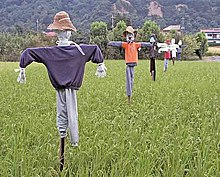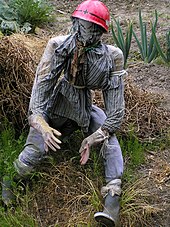A scarecrow is a decoy or mannequin that is often in the shape of a human. Humanoid scarecrows are usually dressed in old clothes and placed in open fields to discourage birds from disturbing and feeding on recently cast seed and growing crops.[1] Scarecrows are used around the world by farmers, and are a notable symbol of farms and the countryside in popular culture.

Design edit

The common form of a scarecrow is a humanoid figure dressed in old clothes and placed in open fields to discourage birds such as crows or sparrows from disturbing and feeding on recently cast seed and growing crops.[1] Machinery such as windmills have been employed as scarecrows, but the effectiveness lessens as animals become familiar with the structures.[2]
Since the invention of the humanoid scarecrow, more effective methods have been developed. On California farmland, highly-reflective aluminized PET film ribbons are tied to the plants to produce shimmers from the sun. Another approach is using automatic noise guns powered by propane gas. One winery in New York has even used inflatable tube men or airdancers to scare away birds.[3]
Cultural impact edit

- Joe's Scarecrow Village in Cape Breton, Canada, was a roadside attraction displaying dozens of scarecrows.[4]
- The Japanese village of Nagoro, on the island of Shikoku in the Tokushima Prefecture, has 35 inhabitants but more than 350 scarecrows.[5]
- In the United Kingdom, where there are a few different languages and several different dialects,[6] there are a wide range of alternative names such as:[7][8]
| Name | Locale |
|---|---|
| Hodmedod.[9] | Berkshire |
| Murmet.[10] | Devon |
| Hay-man.[11] | England |
| Gallybagger.[12] | Isle of Wight |
| Tattie Bogal.[13][14][15] | Isle of Skye |
| Tattie bogle.[9][16]> Bodach-rocais (lit. "old man of the rooks").[11] | Scotland |
| Mommet.[9] | Somerset |
| Mawkin.[9] | Sussex |
| Bwbach.[17] | Wales |
Festivals edit


- In England, the Urchfont Scarecrow Festival was established in the 1990s and has become a major local event, attracting up to 10,000 people annually for the May Day Bank Holiday.[18] Originally based on an idea imported from Derbyshire, or Kettlewell, North Yorkshire,[19] it was the first Scarecrow Festival to be established in the whole of southern England.[20]
- Belbroughton, north Worcestershire, holds an annual Scarecrow Weekend on the last weekend of each September since 1996, which raises money for local charities.[21][22] The village of Meerbrook in Staffordshire holds an annual Scarecrow Festival during the month of May. Tetford and Salmonby, Lincolnshire, jointly host one.[20]
- The festival at Wray, Lancashire, was established in the early 1990s and continues to the present day. In the village of Orton, Eden, Cumbria scarecrows are displayed each year, often using topical themes such as a Dalek exterminating a Wind turbine to represent local opposition to a wind farm.[20]
- The village of Blackrod, near Bolton in Greater Manchester, holds a popular annual Scarecrow Festival over a weekend usually in early July.[20]
- Norland, West Yorkshire, has a Scarecrow festival. Kettlewell in North Yorkshire has held an annual festival since 1994.[23][20] The villages of Cotherstone,[24] Staindrop,[25] and Middleton-in-Teesdale in County Durham have annual scarecrow festivals.[26]
- Scotland's first scarecrow festival was held in West Kilbride, North Ayrshire, in 2004,[27] and there is also one held in Montrose. On the Isle of Skye, the Tattie bogal event[28] is held each year, featuring a scarecrow trail and other events. Tonbridge in Kent also host an annual Scarecrow Trail,[29] organised by the local Rotary Club to raise money for local charities. Gisburn, Lancashire, held its first Scarecrow Festival in June 2014.[20]
- In the US, St. Charles, Illinois, hosts an annual Scarecrow Festival.[31] Peddler's Village in Bucks County, Pennsylvania, hosts an annual scarecrow festival and presents a scarecrow display in September–October that draws tens of thousands of visitors.[32][33]
- The "pumpkin people" come in the autumn months in the valley region of Nova Scotia, Canada. They are scarecrows with pumpkin heads applied to them doing various things such as playing the fiddle or riding a wooden horse. Hickling, in the south of Nottinghamshire, is another village that celebrates an annual scarecrow event. It is very popular and has successfully raised a great deal of money for charity.[34] Meaford, Ontario, has celebrated the Scarecrow Invasion since 1996.[35][36]
- In the Philippines in 2015,[37] the Province of Isabela started a scarecrow festival named after the local language: the Bambanti Festival. The province invites all its cities and towns to participate for the festivities, which last a week; it has drawn tourists from around the island of Luzon.[37]
- The largest gathering of scarecrows in one location is 3,812 and was achieved by National Forest Adventure Farm in Burton-upon-Trent, Staffordshire, UK, on 7 August 2014.[38]
Gallery edit
See also edit
References edit
Further reading edit
Scarecrow Fact and Fable, Peter Haining, 1986
External links edit
 Media related to Scarecrows at Wikimedia Commons
Media related to Scarecrows at Wikimedia Commons Media related to Scarecrow festivals at Wikimedia Commons
Media related to Scarecrow festivals at Wikimedia Commons





